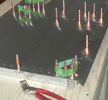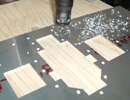


random user submitted photo
CO Detectors
5 posts
• Page 1 of 1
CO Detectors
Hi All,
Good article on http://www.avweb.com about CO detectors. we have an inexpensive little card where the
dot changes color. going to see what the local hardware store has, and aircraft spruce, will upgrade to something with a number readout and aural alarm. Our waiex has a jab 3300. the muffler pipes go into a 3 to one junction. dave amsler came out with a beading tool, which can help for a better fit. also some muffler joint sealant can be used. next annual with the cowling off will make sure all the firewall rivets sealed up , and fuel filler box area is well sealed from the cockpit for fumes.
thoughts? advice from any? any one experience co fumes and remedies?
be safe!
Happy Holidays!
added: just ordered one from walmart online $29.98 free shipping uses 2 AAA batteries.
reading over the posts on CO on this site, things to focus on sealing up: firewall rivets, upper flutes gaps and corners, fuel filler box where it meets the cowl, have a fuel drip pan and well sealed in the box. wing root seals, any holes in the firewall well sealed up. i plan on getting underneath on a creeper, and sealing every rivet with some caulk. our plane is painted white. other spots to seal up near tail spring and vertical spar for rudder.
WaiexN143NM
Michael
Good article on http://www.avweb.com about CO detectors. we have an inexpensive little card where the
dot changes color. going to see what the local hardware store has, and aircraft spruce, will upgrade to something with a number readout and aural alarm. Our waiex has a jab 3300. the muffler pipes go into a 3 to one junction. dave amsler came out with a beading tool, which can help for a better fit. also some muffler joint sealant can be used. next annual with the cowling off will make sure all the firewall rivets sealed up , and fuel filler box area is well sealed from the cockpit for fumes.
thoughts? advice from any? any one experience co fumes and remedies?
be safe!
Happy Holidays!
added: just ordered one from walmart online $29.98 free shipping uses 2 AAA batteries.
reading over the posts on CO on this site, things to focus on sealing up: firewall rivets, upper flutes gaps and corners, fuel filler box where it meets the cowl, have a fuel drip pan and well sealed in the box. wing root seals, any holes in the firewall well sealed up. i plan on getting underneath on a creeper, and sealing every rivet with some caulk. our plane is painted white. other spots to seal up near tail spring and vertical spar for rudder.
WaiexN143NM
Michael
Last edited by WaiexN143NM on Fri Dec 14, 2018 3:11 pm, edited 4 times in total.
- WaiexN143NM
- Posts: 1207
- Joined: Mon Sep 15, 2014 1:04 am
- Location: palm springs CA
Re: CO2 Detectors
Sounds like an interesting problem that doesn’t get much attention, but that maybe should. No point breathing CO just because you don’t know you’re breathing CO...
Gordon
Gordon
Waiex 158 New York. N88YX registered.
3.0 Liter Corvair built, run, and installed.
Garmin panel, Shorai LiFePo batteries.
3.0 Liter Corvair built, run, and installed.
Garmin panel, Shorai LiFePo batteries.
- GordonTurner
- Posts: 669
- Joined: Tue Feb 21, 2012 1:14 am
- Location: NY, NY
Re: CO Detectors
I'm spent a lot of time trying to get CO as low as possible. I went as far as pressurizing the interior of my plane and having a theater fogger inside. This showed me leaks that the flashlight test didn't. As you said, the fuel filler is a good place to start. Another is the 4 corners of the firewall.
While flying, I held my digital CO detector in various places. To my surprise, the air coming in at the wing roots had essentially zero PPM CO. I get around 11 PPM from my cabin heat, but I think once I seal the oil cooler shroud better it will go to zero PPM.
The biggest culprit (once the firewall is sealed tight) while flying is somewhere in the tail. If I hold the detector behind me while flying I read 22 PPM. I've tried to seal the tail with duct tape, but plan spending more time on that in the future.
I could most likely fly safely with the CO levels where they are at right now, but why breath poison while flying. My friends Zodiac 601 reads 0 PPM while flying, so it's possible.
While flying, I held my digital CO detector in various places. To my surprise, the air coming in at the wing roots had essentially zero PPM CO. I get around 11 PPM from my cabin heat, but I think once I seal the oil cooler shroud better it will go to zero PPM.
The biggest culprit (once the firewall is sealed tight) while flying is somewhere in the tail. If I hold the detector behind me while flying I read 22 PPM. I've tried to seal the tail with duct tape, but plan spending more time on that in the future.
I could most likely fly safely with the CO levels where they are at right now, but why breath poison while flying. My friends Zodiac 601 reads 0 PPM while flying, so it's possible.
Paul LaRue
Sonex N454EE Plans# 1509
Jabiru 3300
First Flight 12/21/2017
http://www.mykitlog.com/lpaaruule
Sonex N454EE Plans# 1509
Jabiru 3300
First Flight 12/21/2017
http://www.mykitlog.com/lpaaruule
-

lpaaruule - Posts: 233
- Joined: Wed Mar 26, 2014 6:33 pm
- Location: SE Michigan
Re: CO Detectors
Many moons ago, when first getting my tail dragger in the air, my Guardian CO detector kept showing high levels of CO. Was coming in through the tail. Plugged the small holes in vertical spar for rudder, and one on underside for access to the bolt that holds the tail spring bar in place. End of problem.
David A.
David A.
- DCASonex
- Posts: 935
- Joined: Mon Sep 12, 2011 8:04 pm
- Location: Western NY USA
Re: CO Detectors
My certified airplane, Beech Debonair, has a similar aft fuselage configuration, flat bottom, flat sides, curved top and narrowing to the tail, and the aft fuselage pressurizes in flight which I know because cold air comes forward into the cockpit and in below freezing temperatures the front seat is tee shirt hot and they are cold in the back seat. I have a CO detector and only get CO in ground operations with a tailwind or when downwind from other airplanes with their engines running. So on the Sonex/Waiex, plugging holes in the lower portion and bottom of the aft fuselage should help with the CO in the cockpit problem, and longer tail pipes. Note on the attached picture of the Debonair how far below the fuselage the tail pipes extend, I do not get exhaust stains on the belly. (You may have to zoom in on the photo to see the tail pipes) Stan
- N190YX
- Posts: 80
- Joined: Thu Jun 26, 2014 7:01 pm
5 posts
• Page 1 of 1
Who is online
Users browsing this forum: No registered users and 3 guests







